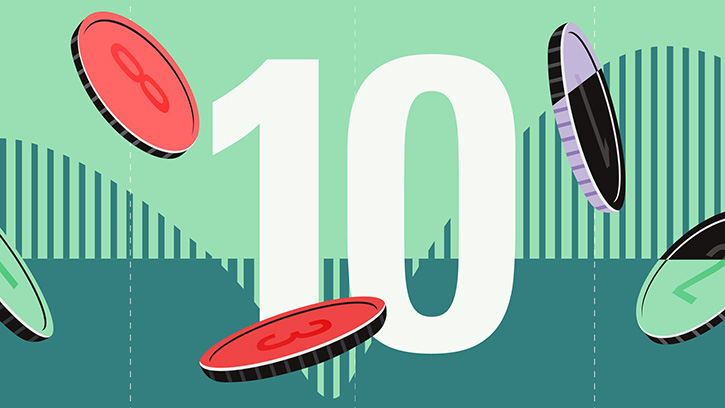Rolle im Portfolio
The CS ETF on MSCI EMU Large Cap provides equity exposure to Eurozone large cap companies. Diversification benefits are limited as the index is highly correlated to international stock markets. The MSCI EMU Large Cap Index correlated 95% with the MSCI Europe Index and 90% with the MSCI World Index over the last three years.
Given the exposure across countries and sectors, the ETF is best deployed as part of a core strategy within a well-diversified portfolio. As the index is tracking the Eurozone only, investors can also use the ETF as a tactical call on the recovery of the Eurozone.
The ETF is suitable for investors seeking a core holding for building a portfolio. Investors with a strong view on the eurozone can also use the ETF to overweight that region, especially if they favour France and Germany but still preferring a more diversified approach.
Before considering an investment, investors should review their existing holdings, especially on a country level, to avoid unintentionally overweighting this region. Germany and France represent 34% and 33% of the index respectively and the MSCI EMU Large Cap Index accounts for over 10% of the MSCI World Index.
Fundamentale Analyse
The economic outlook for Europe remains rather gloomy. The Ifo-Index in Germany, a business confidence indicator, fell to 104.4 in April; down from 106.7 a month earlier and below expectations for a slight retreat to 106.2. In addition, private-sector activity in the Eurozone dropped again in April, while business activities in Germany fell the first time since November. The composite PMI in the Eurozone remained unchanged at 46.5 while pointing towards a further drop in manufacturing output as new orders declined for a 21 straight months to month. Germany’s PMI dropped below the threshold of 50; reaching 48.8, while France PMI eased slightly to 44.2.
The sharp drop in business confidence in the once resilient economy of Germany, coupled with weak economic data in the rest of the monetary union and the absence of inflationary pressures, led the European Central Bank to cut interest rates to a new historical low of 0.50% from 0.75% at its May policy meeting, while leaving the door open for further monetary stimulus should the situation deteriorate.
The latest credit conditions survey from the ECB reported a drop in credit demand from companies and households, underscoring the loss of consumer confidence, despite cheap access to funding. Eurozone GDP has contracted for five consecutive quarters to end 2012, while more recent data suggest a contraction in the first three months of the year as well. Spain has already reported a GDP contraction of 0.5% q/q during Q1-13.
On the back of continuously weak data, international bodies such as the IMF have raised concerns as to whether the austerity measures implemented by many European countries are still the best approach to solve the crisis. The same message has been echoed by European Commission President José Manuel Barroso. Though not abandoning the fiscal austerity principle, the EU has already given Eurozone peripheral countries extra years to achieve their budget deficit elimination programmes, which should thus slow down the pace of cuts and, hopefully, aid growth. .
Accelerating cost cutting by European companies on the back of a gloomy economic outlook should continue to weigh on consumer sentiment as companies lay off workers and close plants. Unemployment in France and Spain is at historical highs, while Germany’s new-car registrations have dropped by 12% y/y. On a positive note, the Italian political gridlock came to an end with the re-election of Giorgio Napolitano as President and the subsequent installation of a grand coalition government headed by Prime Minister Enrico Letta.
Going forward, weak economic indicators for Northern Europe, like Germany, raise concerns that the policy response to the long-running sovereign debt-crisis is starting to also affect these countries. Overall, market consensus points towards a weak summer for the European economy. However, looser austerity measures and a longer time-frame to deliver budget consolidation measures could support an economic recovery.
Indexkonstruktion
The MSCI EMU Large Cap NR USD index includes approximately 70% of the free-float adjusted market capitalisation of all publicly-traded companies from European Monetary Union countries. Components must meet minimum criteria for liquidity, foreign ownership, as well as a waiting period for newly-listed stocks. The securities are weighed by free-float adjusted market capitalisation. Because closely held firms will have a smaller piece of their aggregate market capitalisation floated on public exchanges, the free float adjustment serves to ensure the underlying liquidity of the holdings is superior relative to a pure market capitalisation weighting. The index is reviewed quarterly, with the semi-annual reviews scheduled for May and November more comprehensive than the February and August reviews. As of this writing, there are 114 companies included in the index. French and German equities make up almost 70% of the index. The top sector weighting is financials, which accounts for 20% of the index.
Fondskonstruktion
The CS MSCI EMU Large Cap ETF uses physical replication techniques to track the performance of the MSCI EMU Large Cap index. Because of the size and liquidity of the stocks in the index, the fund does not need to use sampling to keep costs low but can instead hold every stock listed in the index at their index weighting, virtually eliminating one potential source of tracking error. As we write, the CS ETF on MSCI EMU Large Cap is not part of Credit Suisse’s securities lending programme, which means that the fund is free of counterparty risk. Dividends received from the underlying stocks are reinvested in the fund.
Gebühren
The ETF has a total expense ratio (TER) of 0.49%, which is at the top end of the range for ETFs tracking the MSCI EMU Large Cap Index. Other potential costs associated with holding this fund which are not included in the TER include rebalancing costs, bid-ask spreads and brokerage fees.
Alternativen
As of writing, there are many ETFs tracking equities in the euro zone. The largest in terms of total asset under management is the iShares EURO STOXX 50. iShares uses physical replication and levies a total expense ratio of 0.35%.
A more like-for-like alternative is offered by UBS. The UBS-ETF MSCI EMU uses full replication and levies a TER of 0.40% for the retail class and a TER of 0.23% of its institutional share class. For a pan-European exposure, investors can invest in the iShares STOXX Europe 600 ETF. The index offers exposure to the 600 largest stocks from European developed countries and is biased towards the UK (30%), followed by France (15%) and Switzerland (15%). On a sector level, the index favours banks (12%), followed by health care (12%). iShares uses physical replication to achieve its objectives and levies a total expense ratio of 0.20%.
Investors planning to drive a more aggressive strategy can invest in the single country ETFs of Germany and France as they represent 34% and 33% of the index respectively. The largest in terms of asset under management are the iShares DAX ETF and the Lyxor ETF CAC 40.

















